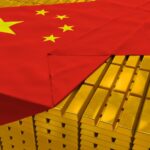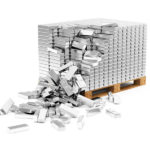Chinese Gold Holdings Estimated at a Whopping 19,500 metric tons
(March 16, 2017- by Valentin Schmid)
The world is full of golden rules. There is one for every field: ethics, communication, fashion. But there is only one that counts, the golden rule of money: “Who has the gold makes the rules.”
China, it seems, wants to make the rules in the international monetary system, which is why it has been acquiring vast amounts of gold both through private and official channels.
Because of the obscure nature of the Chinese gold market and the reluctance of Chinese officials to show their hand, nobody has been able to accurately calculate how much gold the Chinese have amassed since about 2000, when they began amassing it.
Enter Koos Jansen, an analyst with Singapore bullion dealer Bullion Star. He has studied the Chinese gold market for years and recently came up with an estimate of total Chinese gold holdings: 19,500 metric tons, or 21,495 U.S. tons, at the end of January 2017.
“They have promoted gold ownership as a store of value since at least 2002, but more so when they introduced the ‘storing gold with the people’ concept in 2004,” says Jansen, a campaign encouraging private citizens to buy gold.
Private Hoard
According to Jansen’s estimates, total private holdings, including those of individuals and firms, are 15,500 metric tons. The official reserves of the People’s Bank of China (PBOC) are around 4,000 metric tons.
This would make Chinese the second biggest holders of gold after India, where citizens are estimated to hold 20,000 metric tons of gold in jewelry and other forms. Private sector holdings for the United States are unknown, but the Treasury still holds 8,134 tons in official reserves.
But where did China get all this gold when in the year 2000 it only had 4,000 tons in total?
The first piece of the puzzle is domestic mining.
“In the 1970s when China needed foreign exchange, that’s when they started their mining industry. They were supposed to start exploration and the people were incentivized to mine gold. That’s why there are so many gold mines in China.” He pegs the number at around 600.
Those 600 mines produced 490 tons of gold in 2015, making China the biggest producer ahead of Australia with 300 tons.
Importing into a Black Hole
The next piece of the puzzle are imports. According to Jansen’s estimates, China imported about 1,300 tons of gold in 2016, mostly through Hong Kong but also directly from Switzerland and the United Kingdom.
Here, Jansen points out a peculiarity regarding Asian buying: “Asian demand is strong when the price goes down. Western demand is strong when the price goes up. In April 2013, the gold price collapsed and a lot of gold was exported from the West to China, mostly from the U.K.”
When the gold gets into China, it is then sold through the Shanghai Gold Exchange (SGE), which also handles scrap supply and domestic mining.
Curiously, Jansen points out, none of this supply is going to the central bank but rather to consumers and companies.
“In the domestic market, there are laws and incentives to push supplies through the SGE. Scrap, domestic production, imports, all go through SGE at first. The withdrawals from the exchange are equal to total private gold demand.”
Private demand includes individuals who want to diversify their assets or institutional investors, like pension funds but also the gold sold to jewelry companies for later resale.
“Companies and individuals buy gold for the same reason. Get out of the Renminbi, diversify, protection, etc.,” he says.
As for the central bank, Jansen says that their purchases don’t show up in official import statistics and are kept a tight secret.
“The Chinese army even has a special division, I call it the gold army. This gold army can still be active, they can pick it up directly in the U.K.,” he says. The central bank also uses commercial banks who buy in Switzerland or South Africa and secretly ship the gold to China.
For example, the total gold holdings of the London Bullion Market Association dropped by 2,750 tons from 2011 to 2015 but net exports were only 1,000 tons. Thus, those 1,750 tons are unaccounted for and most likely ended up in official Chinese reserves.
According to Jansen’s contacts at Chinese banks, official holdings are closer to 4,000 tons rather than the published figure of 1839 tons.
What does China need that gold for? “They buy official gold to internationalize the renminbi. If there are enough reserves behind it, they can make it a credible currency.” He who has the gold makes the rules.
That’s also why China doesn’t allow even one ounce of gold and silver to leave its shores once it enters. As Jansen put it: “The West has been selling gold into a black hole.”






